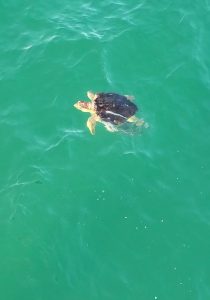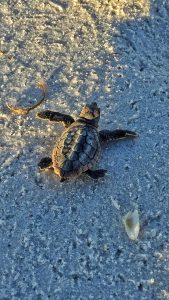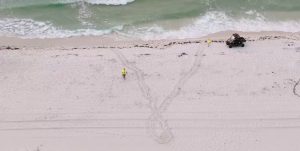
Sea turtles are what biologists like to call “charismatic megafauna”—a jargony way to describe large, easily identifiable wildlife that draw a lot of interest. Like tigers, polar bears, and pandas, sea turtles are fascinating ambassadors of their native ecosystems and often serve as “poster children” for conservation efforts. Ideally, initial interest in these large and attractive animals serves as an introduction to wildlife biology that can help people understand the important role that all living things play in the world.
The five sea turtle species found in Florida waters are protected by the endangered species act, and seeing them in the wild is always a treat. Just this past weekend, I had two friends (one local, one visiting) text me photos of loggerheads they saw in the Gulf. Both described the experience as “magical.” These are gentle reptiles whose female population continues an ancient cycle of leaving and returning to their beaches of origin years later to lay eggs for the next generation.

In northwest Florida, we are currently at the peak of sea turtle nesting season. Officially designated from May 1 to October 31, eggs have an approximately 60-day incubation period. So, eggs laid in the early part of the season are now hatching or getting close to it. Once born, sea turtle hatchlings face a multitude of physical obstacles on the way to the water. Assuming their nests are not damaged or washed out, they must successfully hatch and head towards the brightest light, which for millennia has been the Gulf waters reflecting from the moon and stars. In modern times, hatchlings are more often disoriented than not by ambient light from cities and direct light from buildings along the beach. Even with local ordinances and turtle-friendly lighting, one of the most recent (and successful) hatching events yielded 84 live hatchlings, but 100% of them headed the wrong direction at first.

This is why sea turtle patrols exist, with every nest marked and teams of volunteers and professionals monitoring their progress. Once the expected hatching dates are near, staff are present to subtly redirect the disoriented hatchlings and steer them towards the Gulf. Even when heading straight to the water, young sea turtles must navigate through deep holes dug in the sand, furniture, toys, and trash left on the beach, and away from predatory crabs, coyotes, and sea gulls. Once in the Gulf, they are of course vulnerable to many aquatic predators. On average, only 1 out of 1000 hatchlings survive to adulthood. Therefore, anything we can do to increase their odds is important!

According to Samantha Bolduc with Escambia County Natural Resource Management, “we currently have 41 nests across both county beaches: 34 on Pensacola Beach and 7 on Perdido Key. All are loggerhead, with the exception of a rare Leatherback nest on Pensacola Beach.” Thus far, four nests have hatched, but more will be emerging in the next couple of months.
If you see hatchlings or an adult sea turtle crawling on the beach any time day or night, please call Escambia County Marine Resources at 850-426-1257 or the FWC Wildlife Alert Hotline at 1-888-404-3922 to let them know the location. Keep a safe and respectful distance, and do not attempt to touch them. Females may abandon their efforts to nest if harassed, resulting in a “false crawl” where she turns back to the Gulf, wasting the valuable energy it took her to crawl on land. When fishing, boating, or swimming, you may come across sea turtles feeding underwater near snorkel reefs and fishing piers, or resting at the surface. These sightings do not need to be reported (unless turtles are tangled in plastic or fishing line!), only admired from a distance. By working together to protect sea turtles, we will keep the magic going indefinitely.
 6
6
